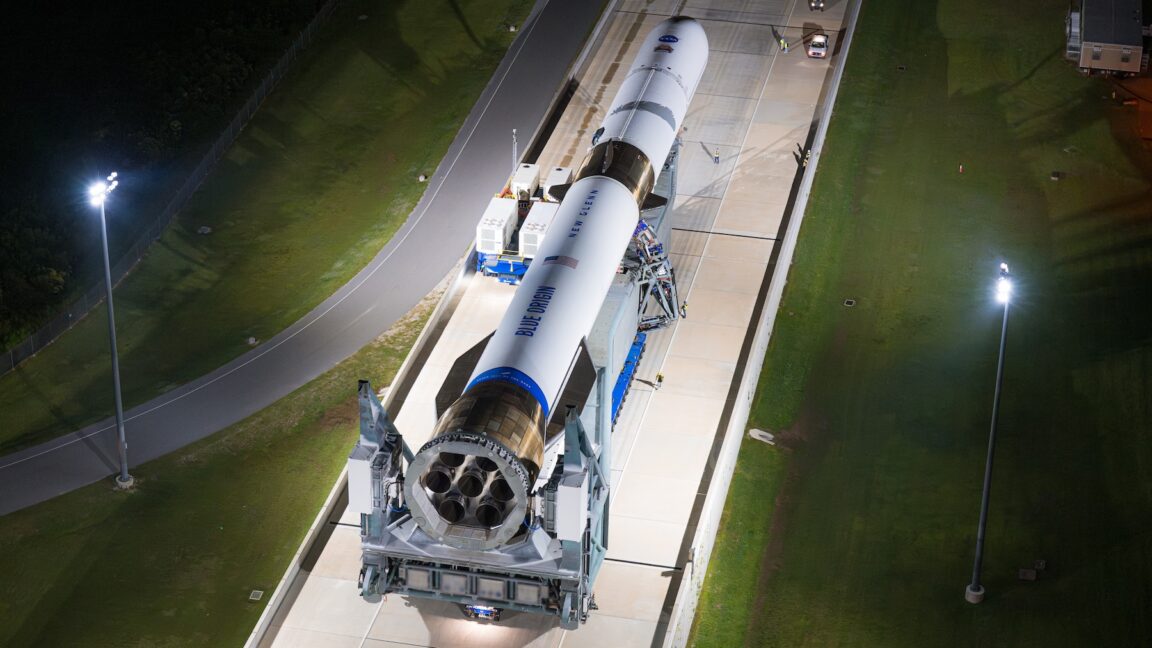Science
NASA’s ESCAPADE Mission Set for Launch After Delayed Preparations

NASA’s ESCAPADE mission is poised to launch towards Mars on Sunday, marking a significant step forward after overcoming a series of delays. The mission, which stands for Escape and Plasma Acceleration and Dynamics Explorers, features two identical spacecraft designed to investigate the interactions between Mars’ upper atmosphere and solar wind. The launch will take place aboard Blue Origin’s New Glenn rocket from Cape Canaveral Space Force Station at 2:45 PM EST (19:45 UTC).
Rob Lillis, the mission’s principal investigator from the University of California, Berkeley, explained that the spacecraft will follow a unique trajectory to reach Mars. Instead of the conventional Hohmann transfer windows, which occur every 25 to 26 months, the ESCAPADE mission will utilize a loiter orbit around Earth. This approach will allow the spacecraft to wait for the optimal alignment of Earth and Mars, expected in November 2025.
Originally, the ESCAPADE mission was designed to take a direct path from Earth to Mars, a journey that typically lasts six to nine months. This new plan means that the spacecraft will depart when Mars is over 220 million miles away, located on the opposite side of the Solar System. The previous Mars launch window was in 2022, and the next opportunity will not arise until late 2026.
The decision to use the New Glenn rocket, despite its overcapacity for the mission, has economic benefits for NASA. The agency is paying approximately $20 million for this launch—significantly less than it would spend on a dedicated launch vehicle. This cost efficiency, however, comes with increased risk, as the New Glenn rocket has not yet been certified by NASA or the US Space Force.
The total budget for the ESCAPADE mission is notably modest for interplanetary exploration, amounting to less than $80 million. This lower cost permits NASA to accept the greater risk associated with launching on the second flight of the New Glenn rocket, which only had its first test flight in January 2023.
Launch Preparations and Technical Details
As of now, the New Glenn rocket is ready for takeoff at Cape Canaveral. Should all systems function correctly, the launch window will open on Sunday afternoon, providing an estimated 65 percent chance of favorable weather conditions, according to Blue Origin.
Megan Lewis, the launch director for Blue Origin, outlined the final preparations for the launch. The rocket will be filled with super-cooled liquid methane and liquid oxygen approximately four-and-a-half hours prior to liftoff. A series of technical and weather checks will precede the terminal countdown, which will culminate in the ignition of the rocket’s seven BE-4 main engines.
Once launched, the New Glenn rocket will travel eastward, breaking the sound barrier shortly after liftoff. It will separate its first stage around three minutes into the flight, allowing a second set of engines to propel the ESCAPADE spacecraft toward a stable position beyond the Moon, known as the L2 Lagrange point. There, the spacecraft will enter a loiter orbit until the timing for their journey to Mars aligns.
Laura Maginnis, Blue Origin’s vice president of New Glenn mission management, emphasized the importance of landing the booster during this launch. After the initial New Glenn flight’s booster failed to land successfully, the team has implemented several changes to the propellant management system to improve the likelihood of a safe recovery.
Innovative Trajectory Planning
The trajectory designed for ESCAPADE resembles a kidney bean shape, a specialized staging orbit that allows the spacecraft to maintain a stable position while waiting for the best moment to proceed to Mars. Jeff Parker, a mission designer from Advanced Space, elaborated on this innovative approach, explaining that the orbit allows for flexibility in launch dates.
This strategy introduces certain challenges, including increased exposure to radiation and additional fuel consumption, which could affect the spacecraft’s scientific operations. The satellites, known as Blue and Gold, were built by Rocket Lab, which equipped them with extra propulsion capabilities to adapt to various launch vehicles.
Richard French, Rocket Lab’s vice president of business development and strategy, noted that while the risks associated with this unique trajectory are higher than originally planned, they have deemed the mission’s risk acceptable. Lillis added that this flexible approach could pave the way for future missions, potentially allowing for the launch of multiple spacecraft to Mars simultaneously, which is essential for expanding exploration efforts.
As the countdown to launch approaches, optimism surrounds the ESCAPADE mission. NASA and Blue Origin are eager to see how this innovative approach to interplanetary travel unfolds, with the hope of advancing our understanding of Mars and its atmosphere. The successful launch of ESCAPADE may serve as a precedent for future space exploration initiatives, creating new opportunities for scientific discovery.
-

 Education3 months ago
Education3 months agoBrandon University’s Failed $5 Million Project Sparks Oversight Review
-

 Science4 months ago
Science4 months agoMicrosoft Confirms U.S. Law Overrules Canadian Data Sovereignty
-

 Lifestyle3 months ago
Lifestyle3 months agoWinnipeg Celebrates Culinary Creativity During Le Burger Week 2025
-

 Health4 months ago
Health4 months agoMontreal’s Groupe Marcelle Leads Canadian Cosmetic Industry Growth
-

 Science4 months ago
Science4 months agoTech Innovator Amandipp Singh Transforms Hiring for Disabled
-

 Technology3 months ago
Technology3 months agoDragon Ball: Sparking! Zero Launching on Switch and Switch 2 This November
-

 Education3 months ago
Education3 months agoRed River College Launches New Programs to Address Industry Needs
-

 Technology4 months ago
Technology4 months agoGoogle Pixel 10 Pro Fold Specs Unveiled Ahead of Launch
-

 Business3 months ago
Business3 months agoRocket Lab Reports Strong Q2 2025 Revenue Growth and Future Plans
-

 Technology2 months ago
Technology2 months agoDiscord Faces Serious Security Breach Affecting Millions
-

 Education3 months ago
Education3 months agoAlberta Teachers’ Strike: Potential Impacts on Students and Families
-

 Science3 months ago
Science3 months agoChina’s Wukong Spacesuit Sets New Standard for AI in Space
-

 Education3 months ago
Education3 months agoNew SĆIȺNEW̱ SṮEȽIṮḴEȽ Elementary Opens in Langford for 2025/2026 Year
-

 Business4 months ago
Business4 months agoNew Estimates Reveal ChatGPT-5 Energy Use Could Soar
-

 Technology4 months ago
Technology4 months agoWorld of Warcraft Players Buzz Over 19-Quest Bee Challenge
-

 Business3 months ago
Business3 months agoDawson City Residents Rally Around Buy Canadian Movement
-

 Technology2 months ago
Technology2 months agoHuawei MatePad 12X Redefines Tablet Experience for Professionals
-

 Business3 months ago
Business3 months agoBNA Brewing to Open New Bowling Alley in Downtown Penticton
-

 Technology4 months ago
Technology4 months agoFuture Entertainment Launches DDoD with Gameplay Trailer Showcase
-

 Technology4 months ago
Technology4 months agoGlobal Launch of Ragnarok M: Classic Set for September 3, 2025
-

 Technology4 months ago
Technology4 months agoInnovative 140W GaN Travel Adapter Combines Power and Convenience
-

 Science4 months ago
Science4 months agoXi Labs Innovates with New AI Operating System Set for 2025 Launch
-

 Top Stories2 months ago
Top Stories2 months agoBlue Jays Shift José Berríos to Bullpen Ahead of Playoffs
-

 Technology4 months ago
Technology4 months agoNew IDR01 Smart Ring Offers Advanced Sports Tracking for $169










